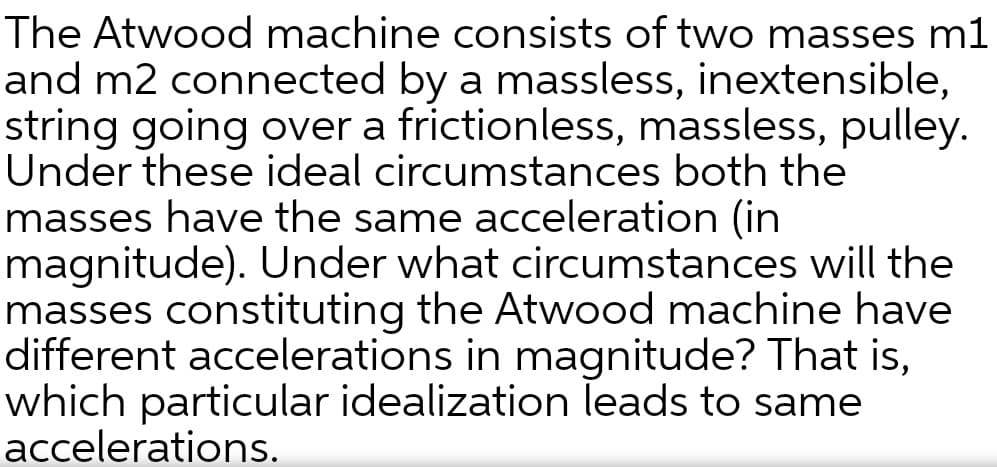The Atwood machine consists of two masses m1 and m2 connected by a massless, inextensible, string going over a frictionless, massless, pulley. Under these ideal circumstances both the masses have the same acceleration (in magnitude). Under what circumstances will the masses constituting the Atwood machine have different accelerations in magnitude? That is, which particular idealization leads to same accelerations.
The Atwood machine consists of two masses m1 and m2 connected by a massless, inextensible, string going over a frictionless, massless, pulley. Under these ideal circumstances both the masses have the same acceleration (in magnitude). Under what circumstances will the masses constituting the Atwood machine have different accelerations in magnitude? That is, which particular idealization leads to same accelerations.
Classical Dynamics of Particles and Systems
5th Edition
ISBN:9780534408961
Author:Stephen T. Thornton, Jerry B. Marion
Publisher:Stephen T. Thornton, Jerry B. Marion
Chapter2: Newtonian Mechanics-single Particle
Section: Chapter Questions
Problem 2.51P: Let us make the (unrealistic) assumption that a boat of mass m gliding with initial velocity v0 in...
Related questions
Question

Transcribed Image Text:The Atwood machine consists of two masses m1
and m2 connected by a massless, inextensible,
string going over a frictionless, massless, pulley.
Under these ideal circumstances both the
masses have the same acceleration (in
magnitude). Under what circumstances will the
masses constituting the Atwood machine have
different accelerations in magnitude? That is,
which particular idealization leads to same
accelerations.
Expert Solution
This question has been solved!
Explore an expertly crafted, step-by-step solution for a thorough understanding of key concepts.
This is a popular solution!
Trending now
This is a popular solution!
Step by step
Solved in 2 steps with 2 images

Knowledge Booster
Learn more about
Need a deep-dive on the concept behind this application? Look no further. Learn more about this topic, physics and related others by exploring similar questions and additional content below.Recommended textbooks for you

Classical Dynamics of Particles and Systems
Physics
ISBN:
9780534408961
Author:
Stephen T. Thornton, Jerry B. Marion
Publisher:
Cengage Learning

Physics for Scientists and Engineers: Foundations…
Physics
ISBN:
9781133939146
Author:
Katz, Debora M.
Publisher:
Cengage Learning

Classical Dynamics of Particles and Systems
Physics
ISBN:
9780534408961
Author:
Stephen T. Thornton, Jerry B. Marion
Publisher:
Cengage Learning

Physics for Scientists and Engineers: Foundations…
Physics
ISBN:
9781133939146
Author:
Katz, Debora M.
Publisher:
Cengage Learning